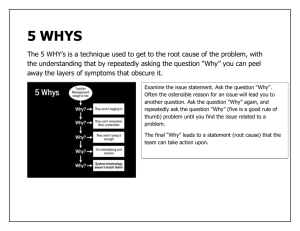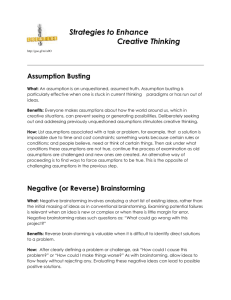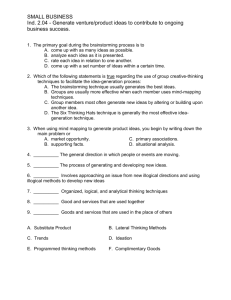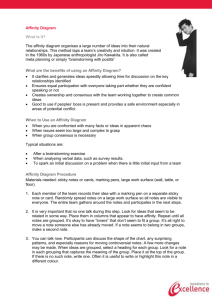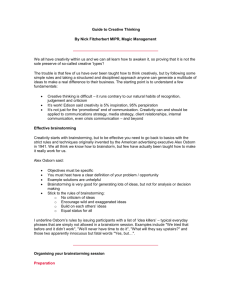AppI.-Generating-ideas-v21
advertisement
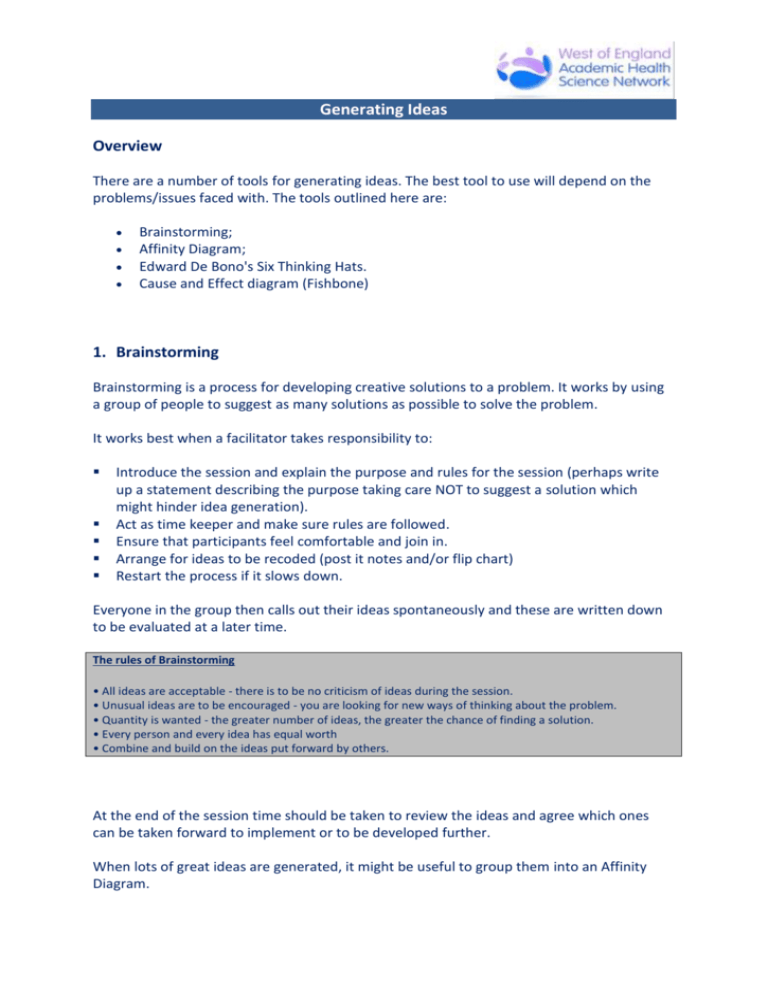
Generating Ideas Overview There are a number of tools for generating ideas. The best tool to use will depend on the problems/issues faced with. The tools outlined here are: Brainstorming; Affinity Diagram; Edward De Bono's Six Thinking Hats. Cause and Effect diagram (Fishbone) 1. Brainstorming Brainstorming is a process for developing creative solutions to a problem. It works by using a group of people to suggest as many solutions as possible to solve the problem. It works best when a facilitator takes responsibility to: Introduce the session and explain the purpose and rules for the session (perhaps write up a statement describing the purpose taking care NOT to suggest a solution which might hinder idea generation). Act as time keeper and make sure rules are followed. Ensure that participants feel comfortable and join in. Arrange for ideas to be recoded (post it notes and/or flip chart) Restart the process if it slows down. Everyone in the group then calls out their ideas spontaneously and these are written down to be evaluated at a later time. The rules of Brainstorming • All ideas are acceptable - there is to be no criticism of ideas during the session. • Unusual ideas are to be encouraged - you are looking for new ways of thinking about the problem. • Quantity is wanted - the greater number of ideas, the greater the chance of finding a solution. • Every person and every idea has equal worth • Combine and build on the ideas put forward by others. At the end of the session time should be taken to review the ideas and agree which ones can be taken forward to implement or to be developed further. When lots of great ideas are generated, it might be useful to group them into an Affinity Diagram. 2. Affinity Diagrams Sometimes a brainstorming session can generate so many ideas that it can take a long time for the facilitator to order and analyse them. Affinity diagrams build the grouping and analysis process into the brainstorming session. It is particularly useful when collating a large volume of ideas, and also helps the group to feel that they own the grouping process. The procedure builds upon brainstorming techniques. In addition to carrying out a ‘silent brainstorm’, the group organises the material in meaningful groupings with appropriate headings. The use of affinity diagrams encourages people to think inventively and make non traditional connections of ideas. The process promotes greater ownership of results, allowing breakthroughs to emerge naturally. How to do it 1. 2. 3. 4. 5. 6. Phrase the issue under discussion in a full sentence e.g. ‘Why are patients waiting so long for test results?’ People then silently record their views on post-it notes. As a minimum, use a noun and a verb, ideally there should be four to seven words on each statement Randomly display the post-its. Without discussion, the group sorts the post-its into 5-10 groupings. If someone disagrees with a grouping, the post-it can be moved, but without discussion Next, create a summary or header card for each grouping to encapsulate the main theme through a rapid team consensus. Avoid one word headers Draw and record the finished diagram by connecting all the heading cards with their groupings Finally, review the result with the team and other key people (stakeholders). Tips Aim to reach a consensus on the choice of words. Neutral, positive or negative statements can all work well in addition to solution orientated questions A typical affinity diagram would have 40-60 items, but could have100-200 ideas depending on the complexity of the problem Large groups of post-its may need to be divided into sub groups You may find it helpful to move headers and groups into a logical sequence. When should it be used? You can use an affinity diagram at any stage of an improvement project, particularly if you anticipate a large volume of ideas. The silent approach to brainstorming is also useful if there are very noisy and or very quiet members of a group. Next Steps This will depend upon why you are using this technique, what you want to get out of it and how it went. You should ensure that either you, or members of the group, follow up the ideas and tell the rest of the group what happened as a result. If you are trying out a new idea, small tests of change are a useful way of initiating action quickly. It might be useful to capture the output in the form of a cause and effect diagram. Sources TIN, now the East Midlands Improvement Network, East London NHS Foundation Trust, and Dave Young © Copyright NHS Institute for Innovation and Improvement 2008 3. Edward De Bono's Six Thinking Hats® Six Thinking Hats® is a concept developed by Edward de Bono. It describes a technique based on the concept of 'parallel thinking' i.e. encouraging everyone to think in the same direction, from the same perspective, at the same time. It helps people to think collaboratively, stepping outside the confines of fixed positions and one way of thinking. This is a useful tool to use during or after the harvesting of ideas as it extends understanding of the idea, helping to determine whether the idea is feasible. You can use it in any context requiring a well rounded view from a variety of perspectives. There are six differently coloured hats, each presenting a particular perspective. Green: ideas Yellow: benefits or positives Black: negatives or risks Red: emotions / gut feeling White: information / data Blue: managing the thinking process In the session Someone in the group 'puts on' the blue hat as the session leader. The blue hat will then agree with other group members on the most useful order of hats to use, and will coordinate their subsequent use, keeping a check on time. The hats have natural pairings: yellow is positive whilst black is more negative; red is emotion driven whilst white is data driven. In general, if you use one hat, you should also use its partner for balance. A useful sequence of hats for initial harvesting of ideas could be: green, yellow, black, white, leading to a final red hat assessment of whether the idea should go forward. Ask leading questions to activate different hats: • Green: How else could we look at this? • Yellow: What are the benefits? • Black: What can go wrong? • Red: What do you feel about this? What is your gut feeling? • White: What are the facts? • Blue: How would we summarise our findings so far? Having reviewed all the ideas using the Six Thinking Hats® tool, you will have narrowed ideas down to the final few. Next Steps Consider what can be realistically tested. Try running some small scale tests of change as a way to decide where to focus efforts such as the Plan Do Study Act cycle in the Model for improvement. Cause and Effect Diagram (Fishbone) What is it? Cause and effect analysis helps you to think through the causes of a problem thoroughly, including its possible root causes. It is only by identifying the main causes that you can permanently remove the problem, or reduce the delay. A cause and effect diagram is a tool that helps you do this. The ‘effect’ is the problem you are working on, for example ‘waiting time’. The tool can help you identify major causes and indicate the most fruitful areas for further investigation. It will help you understand the problem more clearly. A team approach to developing the diagram gains a broader range of insights into the problem, including all possible causes, alongside possible solutions. The people involved benefit from shared contributions, leading to a common understanding of the problem and greater ownership for implementing and sustaining solutions. The cause and effect diagram is sometimes called a fishbone diagram (because the diagram looks like the skeleton of a fish) or an Ishikawa diagram (after its inventor, Professor Kaoru Ishikawa of Tokyo University). Key benefits Enables a team to focus on the content of the problem rather than its history or the differing interests of team members Creates a snapshot of the collective knowledge and consensus of a team around a problem Focuses the team on the root cause of the problem – not its symptoms Example Firstly, identify the problem. Write it in a box and draw an arrow pointing towards it. Think about the exact problem in detail. Where appropriate, identify who is involved, what the problem is, and when and where it occurs. Identify the major factors and draw four or more branches off the large arrow to represent main categories of potential causes. Categories could include: equipment, environment, procedures, and people. Make sure that the categories you use are relevant to your particular problem / delay. An alternative way of creating the branches of a cause and effect diagram is to carry out the Affinity Diagram technique and use the group headings produced there. For Example: Take each of the main categories and brainstorm possible causes of the problem. Then, explore each one to identify more specific ’causes of causes’. Continue branching off until every possible cause has been identified. Where a cause is complex, you might break it down into sub-causes. Show these as lines coming off each cause line. Analyse your diagram. By this stage you should have a diagram showing all the possible causes of your delay / problem. Depending on the complexity and importance of the problem, you can now investigate the most likely causes further. This may involve setting up interviews (see getting patient perspectives), carrying out process mapping or surveys which you can use to decide whether the causes identified are correct. Tips: Make sure that your team members agree on the problem statement. Include as much information as possible in the ‘what’, ‘where’, ‘when’ and ‘how much’ of the problem. Use data to specify the problem if possible Aim to construct the diagram with the people involved in the problem You can use a cause and effect diagram as a working document that is updated as and when you collect more data, or to trial various solutions Use a paper surface so that you can transport the final diagram Ideally, causes should appear in only one category, although some people causes may overlap Watch this video clip for more information Cause and Effect - You Tube Video Please click here to download a template for you to use yourself More examples Acknowledgements / sources TIN, now the East Midlands Improvement Network, East London NHS Foundation Trust and Dave Young. © Copyright NHS Institute for Innovation and Improvement 2008 3.
